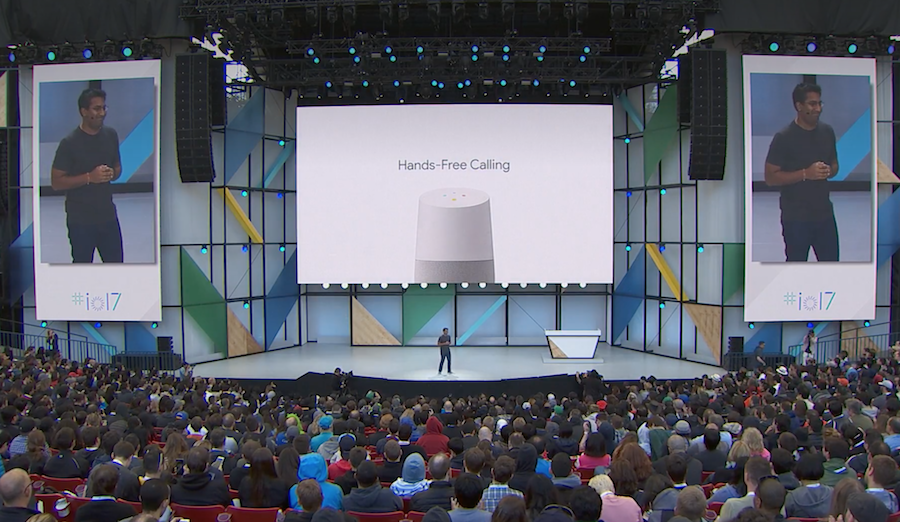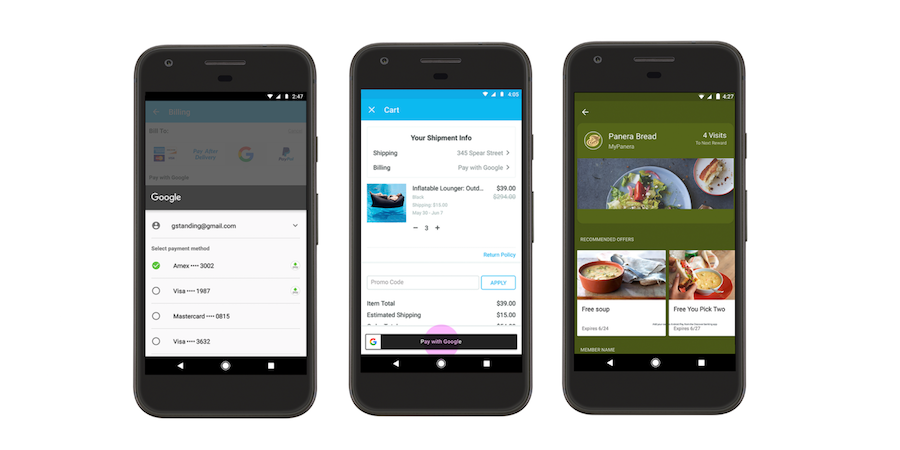7 Google IO AI and Voice Announcements That Really Matter

There were several Google IO AI and voice announcements this week that were significant and offer a glimpse into how the technology landscape is changing. The developer conference had a key theme this week: Mobile First to AI First.
Google’s Android OS is the dominant smartphone platform globally with over 85% market-share. It is noteworthy that the company isn’t straining to convince everyone about how important mobile is for the future and reminding them about Google’s dominance. This isn’t a company breathlessly focused on its past success and current market strengths. Google is instead focusing on new platforms, AI and Voice, where it is in a pitched battle against giant tech rivals with comparably substantial resources and assets.
Give Google credit for self-awareness. The company recognizes the AI and voice technology platform shifts may undermine its many current advantages and is embracing a fiercely competitive future. There were many announcements yesterday, but seven stood out as particularly important:
- AI
- Scale
- Geographic Expansion
- Payments
- Partners
- Voice Assistant Features
- Voice Assistant Futures
Proliferating Google’s AI Tools and Applications
One of the big focus areas was AI and it was important enough to be presented by CEO Sundar Pichai.
Our new Cloud TPUs accelerate a wide range of machine learning workloads, including training and inference → http://t.co/aWvTVMn54Q #io17 pic.twitter.com/Bm5e8Gud6s
— Google (@Google) May 17, 2017
The Verge did a nice job of characterizing the import of AI to Google’s long-term technology roadmap and competitive positioning.
“During the opening remarks of the I/O keynote today, Pichai announced Google’s next-generation Tensor Processing Unit, a specially designed chip for machine learning that works on the company’s TensorFlow platform. This new TPU chip effectively makes building AI on Google’s platform incredibly fast and efficient, more so than with hardware and machine learning platforms used by competitors.
“With TPU and TensorFlow being optimized to work together, Google is effectively transforming its cloud computing platform into the Android for AI. This is a big deal for Google’s future. If the company can own the hardware and software used by the most cutting-edge AI researchers, it can stay at the forefront of the field and have its hand in every exciting advancement that machine learning, and every other AI breakthrough, yields in the future.”
Scale
A theme that was implicit throughout the keynote presentations was that Google thinks and acts at scale. Voicebot has written about 8-10 million smart speakers in use in 2016 and another 24 million in 2017 bringing needed scale and critical mass to the market. Even 92 million forecasted smart speakers in the US in 2020 seems small compared to Google’s numbers today. The company announced 2 billion monthly active Android devices and 100 million Android devices with access to Google Assistant.
Thanks to developers and our partners around the world, there are now more than 2 billion monthly active Android devices. #io17 pic.twitter.com/tMH6aHsAIP
— Google (@Google) May 17, 2017
Existing installed based from Google’s mobile and infrastructure businesses as well as other web properties represent the company’s biggest competitive assets. They were on full display at IO.
Geographic Expansion
Google announced planned availability this summer for Google Home in Japan, France, Germany, UK, Canada and Australia. It also indicated that Google Assistant will support Portuguese, Spanish and Korean before the end of the year. These may be the biggest announcements of the entire day because being first or very early to market in a country or for a language has been a significant advantage to date for Amazon. It is very likely that Google will beat Amazon to market in several of these categories.
Also important is the fact that Apple has its own voice assistant initiatives and already includes strong support through Siri for all of these languages. Apple could announce or launch an upgraded Siri assistant at its Worldwide Developer Conference (WWDC) in June for any number of languages. Remember that Apple Music launched with support for 100 countries. Siri appears behind Alexa and Google Assistant today, but could quickly leapfrog the competition with a rapid global roll-out. Microsoft Cortana seems destined for B2B applications. Google’s competitive focus today must be the two-front battle with Amazon and Apple for B2C voice assistant dominance.
Payment Transactions

Another important announcement that seems to be getting little notice is the introduction of payment transactions for Google Assistant. Amazon Echo has had great success in getting Prime members to re-order through Alexa. Google in introducing an API that offers a more robust user experience that can be customized by Google Action developers. The new solution has five components.
- Payments
- Identity
- Notifications
- Receipts
- Account Creation
There has been a lot of discussion recently about how developers will generate revenue on voice assistant platforms. Amazon allows advertising for media on Alexa and announced a program to reward game developers of popular skills with cash payouts. Google has not taken any steps in that direction yet, but the introduction of transactions may reduce the friction for consumer purchases and affiliate sales programs. There is utility for consumers and producers that transactions could address.
Features
There were many feature announcements that directly impacted Google Assistant. The first two will bring Google to parity with recent Amazon announcements and the others will take Google Assistant well ahead of Alexa if consumers find them valuable.
- Proactive assistance – Similar to notifications announced earlier in the week by Amazon, but potentially more robust. The theory is that Google’s vast array of apps and data can help tailor alerts to include contextual information such as travel time and anticipate needs. It will be interesting to see if the execution is good on implementing these features.
- Calling – Call any landline or mobile phone in the US or Canada completely free. That feature, when launched, will likely match Amazon Alexa’s current calling and messaging feature.
- Text interaction – There wasn’t much detail on this, but being able to interact with Google Assistant by voice or text is a nice concept when you want to keep an interaction private or just quiet.
- Google Lens – This is a really interesting feature that ties visual references to information gathering or task execution by simply capturing an image. It is hard to see Amazon matching this soon.
With Google Lens, your smartphone camera won’t just see what you see, but will also understand what you see to help you take action. #io17 pic.twitter.com/viOmWFjqk1
— Google (@Google) May 17, 2017
- Visual responses – The ability to request something from Google Assistant and display it on a screen such as a television. This seems like a useful feature, but I suspect most people will hold onto their habit of referencing their phone instead of television screen when a visual reference is helpful.
Futures
The final takeaway from Google IO is that we mostly heard about future features, also know as futures. There were a few new features in place now, but most were referred to as available soon, this summer, or later in 2017. Amazon has a habit of announcing features when they are available. An exception was the notifications feature which was announced just before Google IO as coming soon to Alexa. The company certainly anticipated Google’s announcement around proactive assistance and wanted to pre-empt the feature. However, neither are available yet.
Google laid out a big vision and a lot of tangible features and products to drive that vision forward. The question now is twofold. Will Google be able to execute and bring these products and features to market in a timely fashion and working as advertised? Second, will consumers care? So Google may have spoken mostly about what is coming, but if they deliver, many people will be pleased because what is coming looks worth waiting for.
Google Home Coming to UK, Germany, France, Japan, Canada and Australia
Google Assistant Now Available on 100 Million Android Devices








